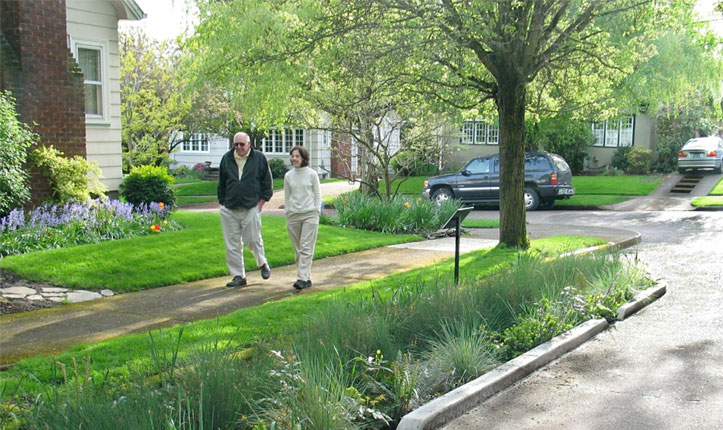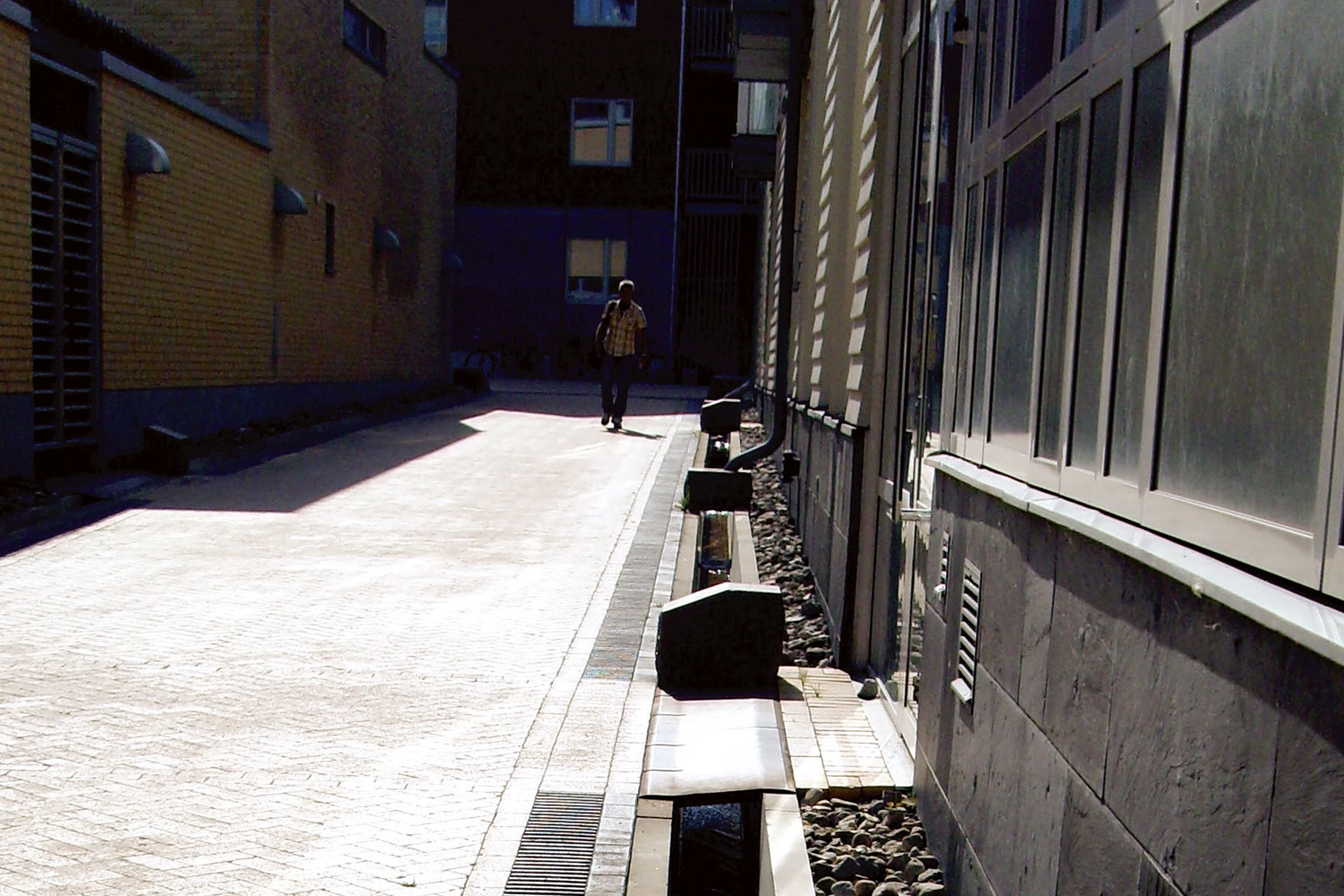Urban stormwater is typically managed through underground pipes, or “grey” infrastructure. District stormwater management systems focus on the hydrological cycle and on intercepting, infiltrating, detaining and evapotranspiring as much rainfall as possible rather than conveying surface runoff into pipes and streams. This approach is known as “green” infrastructure, and can also be described as preserving the local on-site water balance. District-scale approaches not only reduce the amount of stormwater available for runoff, but also reduces the pollution from urban nonpoint sources that enter local streams. Stormwater management infrastructure still has to deliver on all design objectives, which can generally be listed as local water balance maintenance, flood protection, erosion control and stormwater quality enhancement. Neighborhood-scale stormwater management should begin with rainwater management at the site or individual property level and then scale up to the watershed level. Examples of innovations at the property level include harvesting roof runoff, treating and reusing water, managing rainwater by infiltration into swales and soil in bio-retention areas, minimizing impervious surfaces, and using pervious pavement. At the neighborhood level, runoff impacts are mitigated by designing roads without curbs, gutters or drain pipes, and by diverting runoff into infiltration channels, swales, and wetlands. Other examples of neighborhood-scale stormwater management systems include green roofs and curb extensions.
BENEFITS
ENVIRONMENT
- Less energy intensive than conventional systems
- Reduces contaminants that can enter urban streams by preventing nonpoint source pollution
- Lessens runoff
- Improved stormwater quality through removal of sediment using strategies such as pervious pavements
EQUITY AND COMMUNITY
- Development and installation of appropriately scaled systems that can meet fluctuating community needs while still providing the expected convenience of managed stormwater
- Reduces non-point source pollution and sediment loads that enter local streams
- Bioswales and retention ponds double as attractive neighborhood amenities and contribute to overall neighborhood greening
ECONOMIC
- Less capital intensive than conventional systems (reduced need for long-distance piping, storm sewers, and associated infrastructure)
- Reduced paving costs by minimizing width of roads and directing runoff into roadside infiltration swales
BARRIERS TO IMPLEMENTATION
INSTITUTIONAL
The shift from grey to green necessitates a fundamental change in the relationship between public utilities and property owners. Residential property owners pursuing new kinds of green infrastructure may face delayed permitting processes because projects do not follow typical standards. Decreased space between buildings and the amount of property “sacrificed” to create the stormwater system also is a perceived barrier.
CULTURAL
Common cultural barriers include the belief that stormwater management is the city’s problem. A related challenge is lack of awareness about program and design alternatives and insufficient information about potential effects on property. These barriers can be overcome through public outreach programs.

CASE STUDY: NORTHEAST SISKIYOU GREEN STREET
STRATEGIC PARTNERS
The Northeast Siskiyou Green Street project in Portland, Oregon is a good example of an effective public-private partnership with the Portland Bureau of Transportation and local property owners. The simple street modification fully integrates stormwater management into the local streetscape, resulting in an attractive amenity for local property owners. The Bureau of Environmental Services worked with neighboring property owners to design the infiltrating areas to complement private landscaping. Property owners agreed to assist with simple maintenance once the City plantings were established.
FINANCING
The Innovative Wet Weather Program in Portland is an initiative to develop projects that manage and treat runoff from the city’s developed areas. The goal of this program is to keep runoff from entering the stormwater system when possible or to manage the water before it is released. In 2003 and 2005, the City of Portland was awarded two federal grants totaling $1.68 million to further invest in these and other public and private projects that demonstrate sustainable stormwater management solutions. The City of Portland added another $1.35 million in matching funds. The total cost of the NE Siskiyou project, including management, design, and construction, was $20,000, of which $3,000 was used for ancillary street and sidewalk repairs that might not be needed for similar projects. For the stormwater curb extensions alone, the total cost was $17,000, or $1.83 per square foot of impervious area managed.
IMPLEMENTATION
The projects constructed under the Green Streets category of the Innovative Wet Weather Program must accomplish the goals of reducing the occurrence of overflows where sanitary and storm sewers are combined, treating polluted runoff, and increasing the amount of vegetation in the city. Both public and private projects must consider the category and range of the goals in this category and range for simple retrofits and new pervious paving surfaces. The NE Siskiyou Green Street is a demonstration project that essentially disconnects the street’s rainwater runoff from the city’s combined storm/sewer pipe system and manages the water onsite using a landscape approach. With the new stormwater curb extensions now in place, nearly all of NE Siskiyou’s annual street runoff, estimated at 225,000 gallons, is managed by its landscape system. In fact, the curb extensions have the ability to reduce the runoff intensity of a typical 25-year storm event by 85 percent.
LESSONS LEARNED
- As the environmental and economic costs associated with maintaining and operating city-scale sewer systems continue to escalate, installation of appropriately scaled systems that can meet the fluctuating needs of a community while still providing the expected convenience of managed stormwater runoff is the solution for the future.
- Local and state incentives are important vehicles to decrease the initial cost of stormwater management within green buildings. Sites promoting financial strategies and management alternatives are essential for neighborhood-scale stormwater management. Extensive public outreach programs are opportunities for fundraising and for communities to come together to support the initiative.
- Removing regulatory barriers, such as slow permit processes, can help spur the market for property owners to pursue decentralized and distributed systems, thus bringing down upfront costs.
- Cultural barriers such as perceived risk of basement flooding (e.g., from downspout disconnection) can be overcome by outreach programs and incentives organized by the City or nonprofits.
OTHER EXAMPLES
- MONTGOMERY, MD White Oak Neighborhood Stormwater Retrofit
- FORT WRIGHT, KY Northern Kentucky Sanitation District No. 1 Project
- PORTLAND, OR Taggart D—1,200-acre G.I. Retrofit
- UTICA, NY Green Innovation Grant Program (stormwater tree pits and rain barrels)

